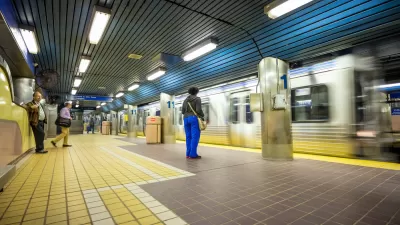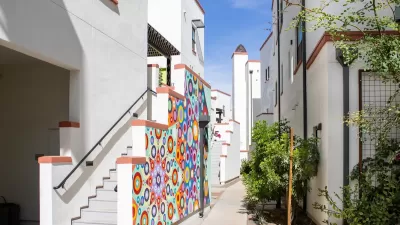While not all parts of the city are equally accessible, its central district boasts one of the nation’s densest transit networks and high ridership rates.
!["I [heart] Philadelphia" sign in front of fountain with city hall building in background](/files/styles/featured_small/public/images/AdobeStock_514479381_Editorial_Use_Only.jpeg.webp?itok=UkGD4UWa)
A report from CoworkingCafe rates Philadelphia as one of the best U.S. cities to live in without owning a car, reports Ariana Perez-Castells in The Philadelphia Inquirer. “The study considered how often people walk, use public transportation, drive a car, or bike, as well as the cost of public transit and how packed public transit stations and bike lanes are, among other factors.”
One contributing factor is that Philadelphia’s public transit system has an unusually dense station network, with more than two transit stations per square mile. “And 21.4% of the population uses public transit, according to the report.”
The article notes that not all parts of the city are as accessible and walkable as the city’s center. Additionally, “Construction on sidewalks throughout Philadelphia is often a hurdle for pedestrians, says Guerra. Construction sites don’t always set up alternative safe sidewalks, so people are funneled into the road.
FULL STORY: No car, no problem: Philly is one of the best U.S. cities to live in without a personal vehicle

Study: Maui’s Plan to Convert Vacation Rentals to Long-Term Housing Could Cause Nearly $1 Billion Economic Loss
The plan would reduce visitor accommodation by 25,% resulting in 1,900 jobs lost.

North Texas Transit Leaders Tout Benefits of TOD for Growing Region
At a summit focused on transit-oriented development, policymakers discussed how North Texas’ expanded light rail system can serve as a tool for economic growth.

Why Should We Subsidize Public Transportation?
Many public transit agencies face financial stress due to rising costs, declining fare revenue, and declining subsidies. Transit advocates must provide a strong business case for increasing public transit funding.

How to Make US Trains Faster
Changes to boarding platforms and a switch to electric trains could improve U.S. passenger rail service without the added cost of high-speed rail.

Columbia’s Revitalized ‘Loop’ Is a Hub for Local Entrepreneurs
A focus on small businesses is helping a commercial corridor in Columbia, Missouri thrive.

Invasive Insect Threatens Minnesota’s Ash Forests
The Emerald Ash Borer is a rapidly spreading invasive pest threatening Minnesota’s ash trees, and homeowners are encouraged to plant diverse replacement species, avoid moving ash firewood, and monitor for signs of infestation.
Urban Design for Planners 1: Software Tools
This six-course series explores essential urban design concepts using open source software and equips planners with the tools they need to participate fully in the urban design process.
Planning for Universal Design
Learn the tools for implementing Universal Design in planning regulations.
Ascent Environmental
Borough of Carlisle
Institute for Housing and Urban Development Studies (IHS)
City of Grandview
Harvard GSD Executive Education
Toledo-Lucas County Plan Commissions
Salt Lake City
NYU Wagner Graduate School of Public Service





























